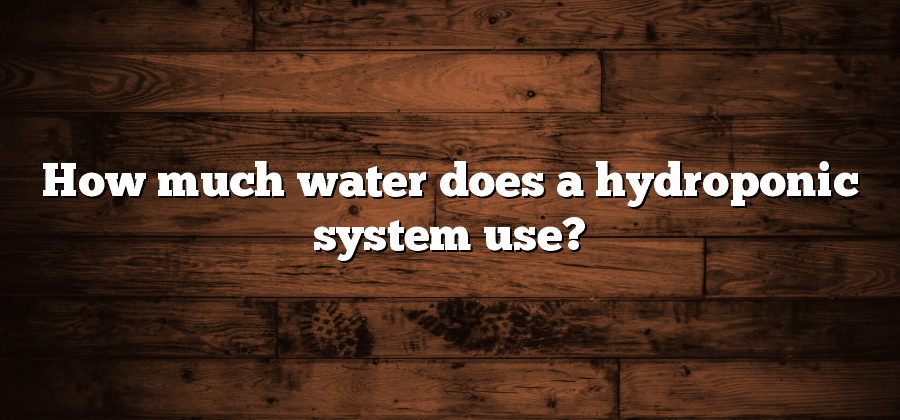Understanding the Water Needs of Hydroponic Systems
Hydroponic systems, the innovative method of growing plants without soil, require careful consideration of their water needs. Unlike traditional soil-based cultivation, hydroponics relies on a nutrient-rich water solution that is continuously circulated around the plant roots. This water acts as both a medium for the plants to absorb nutrients and a source of hydration. Understanding the water needs of hydroponic systems is crucial for optimizing plant growth and ensuring the overall success of the cultivation process.
One of the key factors that determine the water needs of a hydroponic system is the type of plants being grown. Different plant species have varying water requirements, with some needing more frequent watering and others less. Factors such as the stage of plant growth, the size of the plants, and the environmental conditions in which they are grown also play a role in determining water needs. By closely monitoring and adjusting the water supply, hydroponic growers can ensure that each plant receives adequate hydration, promoting healthy growth and development.
Evaluating Water Usage in Hydroponic Cultivation
Water usage is a critical aspect of hydroponic cultivation that requires careful evaluation. In order to ensure the sustainability and efficiency of hydroponic systems, it is essential to understand the factors that influence water consumption and to optimize water usage accordingly. By evaluating water usage in hydroponic cultivation, growers can identify areas for improvement and implement strategies to reduce water wastage.
One of the key factors influencing water consumption in hydroponics is the type of hydroponic system being used. Different systems, such as nutrient film technique (NFT), deep water culture (DWC), or aeroponics, have varying water requirements. NFT systems, for example, use a thin film of water flowing over the roots, resulting in lower water usage compared to DWC systems where the roots are fully submerged. Evaluating the specific water needs of each system allows growers to better understand their water usage and make informed decisions regarding irrigation schedules and water management.
Another important factor to consider when evaluating water usage in hydroponic cultivation is the type of crops being grown. Different plants have varying water requirements, and understanding these needs is crucial for efficient water management. Leafy greens, for instance, generally have higher water requirements compared to fruiting crops. By evaluating water usage in relation to crop types, growers can tailor their irrigation practices and nutrient deliveries to ensure optimal water usage and minimize water wastage.
In conclusion, evaluating water usage in hydroponic cultivation is a vital step towards optimizing water efficiency. By considering factors such as the type of hydroponic system and crop varieties, growers can make informed decisions regarding water management, leading to more sustainable and productive hydroponic systems.
Factors Influencing Water Consumption in Hydroponics
Hydroponics, as a soilless method of growing plants, has gained significant popularity due to its numerous benefits. However, one important factor that growers need to consider is water consumption in hydroponics. Several factors can influence the amount of water needed for hydroponic systems, and understanding these factors is essential for optimizing water efficiency and ensuring successful cultivation.
Firstly, the type of hydroponic system used plays a crucial role in water consumption. Different systems, such as deep water culture, nutrient film technique, and aeroponics, have varying water requirements. For example, deep water culture systems may require more water to maintain the required nutrient levels, while aeroponic systems, which use misting to deliver nutrients, may use less water overall. Understanding the water needs of each specific hydroponic system is vital to ensure adequate supply is provided without excessive wastage.
Optimizing Water Efficiency in Hydroponic Systems
One key aspect in optimizing water efficiency in hydroponic systems is to closely monitor and regulate water usage. By regularly measuring the water levels and analyzing the irrigation system, growers can identify any leaks or inefficiencies that may be wasting water. Implementing sensors and automated controls can help maintain precise water levels, ensuring that plants receive the appropriate amount of moisture while minimizing wastage. This not only promotes sustainable water usage but also reduces costs associated with excessive water consumption.
Additionally, choosing the right growing medium is crucial for optimizing water efficiency. Certain mediums, such as coconut coir or rock wool, have the ability to retain moisture effectively while still providing sufficient aeration for the roots. This helps to minimize water loss through evaporation and ensures that the plants receive a consistent supply of water. Evaluating and selecting the appropriate growing medium according to the specific needs of the plants can significantly improve water efficiency in hydroponic systems.
Measuring and Monitoring Water Usage in Hydroponics
Hydroponic systems offer a more water-efficient alternative to traditional soil-based agriculture. As water is a precious resource, it is essential for growers to measure and monitor their water usage in hydroponic systems. By understanding how much water is being used, growers can optimize their systems and minimize waste.
There are various methods to measure and monitor water usage in hydroponics. One common approach is through the use of flow meters, which measure the volume of water passing through the system. By tracking the flow rate, growers can calculate the daily, weekly, or monthly water consumption of their system. Another method is the use of water level sensors, which provide real-time data on the water level in the system. This allows growers to identify any fluctuations or irregularities that may indicate leakage or inefficient water usage. Additionally, advanced monitoring systems can integrate sensors that measure variables such as temperature, humidity, and nutrient levels, providing a comprehensive understanding of the overall water management in the hydroponic system.






